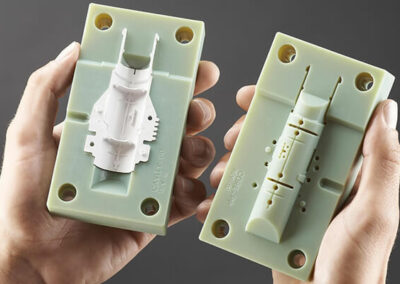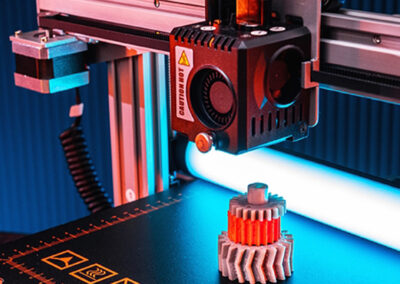3D Printing VS. Injection Molding: Cost Analysis
When choosing a processing method, we often think about which one is cheaper, 3D printing or injection molding? Therefore, a careful comparison of the cost factors of these two production processes is necessary. First, 3D printing is great for rapid prototyping, low-volume production, and custom production, but it can be more expensive for mass production. Secondly, injection molding requires a higher upfront cost, but as production scale expands, the cost of each part will gradually decrease, making it more economical. It can be seen that when selecting the processing method suitable for the project, we should consider the specific project requirements, production scale and budget constraints, and conduct a detailed cost analysis to determine the most economical solution.
Calculate Injection Molding Costs
Determining the cost of creating an injection molding mold depends on several pivotal factors, which encompass:
-
- Product Size:
The physical dimensions of the product are a significant cost influencer. Larger products require more material, increased mold size, and consequently, higher production costs. - Material Selection:
The choice of material plays a pivotal role in cost estimation. Different materials vary in price and properties, influencing both material and processing costs. - Product Complexity:
The intricacy of the product design, including the number of components, features, and undercuts, can substantially affect mold complexity and, subsequently, its cost.
- Product Size:
These three core elements exert the most profound influence on the overall investment required for mold creation. Depending on the interplay of these factors, mold costs can range from as low as $500 to well over $10,000.
The specific requirements and intricacies of your project will be the ultimate determinants of mold cost. It is vital to conduct a detailed assessment considering these factors to obtain an accurate estimate for your injection molding project.
Calculate 3D Printing Costs
With the increasing availability of 3D printing, the idea of acquiring an in-house printer for production is becoming a viable option for numerous manufacturers. This approach empowers manufacturers to create products at a favorable cost structure, with expenditure primarily centered around materials and maintenance.
Once the cost of printing a particular component has been established, it generally remains consistent regardless of the production volume. Given the limited upfront investment, 3D printing can prove to be a cost-efficient solution in specific scenarios. The following are some application scenarios of 3D printing:
-
- Low-Volume Production:
When a project necessitates the creation of fewer than 100 parts, 3D printing often emerges as the more economical choice. The absence of significant initial setup costs makes it a cost-effective solution for limited production runs. - Rapid Prototyping and Revisions:
3D printing excels when a project is expected to undergo multiple design iterations. It facilitates quick adjustments and revisions. - Time Sensitivity:
In situations where the demand for parts is time-sensitive, 3D printing’s swift turnaround can be a substantial advantage. - One-Time Projects:
For projects with a one-time production requirement, not entailing ongoing production, 3D printing offers a competitive edge. It eliminates the need for extensive tooling or molds associated with other manufacturing methods.
- Low-Volume Production:
3D Printing VS. Injection Molding: Comparison of Advantages
Both 3D printing and injection molding are versatile manufacturing methods used to produce a wide spectrum of products, spanning from everyday items to bespoke creations. Understanding the unique attributes of each process is crucial for making informed decisions based on project requirements. Here, we delve into the respective advantages of these two manufacturing systems:
-
- Precision and Detail:
Injection molding excels in achieving high levels of detail and precision. It is the go-to choice for creating components with intricate features or those that require meticulous resolution. Prototypes intended for investor presentations or public displays benefit from injection molding, as it allows them to closely emulate the fine details of the finished product.
- Precision and Detail:
Material Waste and Recycling:
An area of distinction between the two methods lies in waste generation and recycling. 3D printers produce scaffolding, which can be challenging to repurpose. In contrast, injection molding utilizes runners, and the implementation of a hot runner system can effectively eliminate waste. This waste reduction not only supports environmental sustainability but also contributes to cost efficiency in high-vulume production.
-
- Complexity and Customization:
3D printing offers remarkable flexibility for creating intricate, custom, and one-of-a-kind designs. It’s an ideal choice when product customization or rapid prototyping is the primary goal. Injection molding is better suited for standardized and large-scale production. - Speed and Scalability:
3D printing is known for its rapid prototyping capabilities, allowing for quick design iterations and shorter lead times. However, for mass production, injection molding offers superior scalability and faster production once the molds are ready.
- Complexity and Customization:
3D Printing VS. Injection Molding Cost
When evaluating the cost aspect of 3D printing and injection molding, a fundamental difference comes to light: the price per unit. Each method operates under distinct cost dynamics:
-
- Injection Molding:
The primary cost in injection molding resides in the upfront investment – the creation of the mold. The more parts a mold produces, the more cost-effective it becomes per unit. Injection molding’s cost efficiency grows as production volume increases. - 3D Printing:
With 3D printing, the price per unit changes minimally. It is influenced by the cost of materials and the time required per unit, remaining relatively consistent regardless of production volume.
- Injection Molding:
Initially, manufacturing a mold and the first batch of injection-molded parts may incur higher costs than 3D printing. However, when the need arises for subsequent production runs, the price per unit for injection molding becomes more favorable. Beyond that point, each additional order of parts offers increasing cost savings.
Furthermore, many 3D printers leverage batch processing, enabling the simultaneous production of multiple parts. The efficiency of 3D printing improves up to the point at which the build tray is fully utilized.
For low-volume or rapid prototyping, 3D printing can be cost-effective. In contrast, for mass production and larger production runs, injection molding’s per-unit cost-efficiency makes it the preferred choice.
3D Printing VS. Injection Molding: Which Is Right for Your Product?
By reading this article, you have gained an initial understanding of the cost factors of 3D printing and injection molding. However, when choosing a manufacturing method, we need to consider not only cost but also the other needs of the project. Injection molding is a more suitable choice for mass production and plastic parts that require a combination of cost, speed and accuracy. For products produced in low volumes that urgently require quick response and unique design, 3D printing is undoubtedly the best choice. If you are still confused about whether to choose 3D printing or injection molding, please feel free to contact us and we will provide professional advice to meet your specific needs.
Get a free quote and design analysis today.
We’ll reply to you within 6 working hours.
We respect your privacy.
+86 139 2927 4777 (WhatsApp, Wechat)


